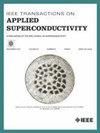Damage Limits of $\text{Nb-Ti}$ and $\text{Nb}_{3}\text{Sn}$ Superconductors Due to High-Intensity Beam Impact
IF 1.8
3区 物理与天体物理
Q3 ENGINEERING, ELECTRICAL & ELECTRONIC
引用次数: 0
Abstract
High-energy hadron colliders with multi-TeV centre-of-mass energies require high-field superconducting magnets. Examples include the large hadron collider (LHC) and its high-luminosity upgrade (HL-LHC), as well as future projects such as the future circular collider (FCC-hh) and super proton–proton collider (SPPC). During operation, these magnets are exposed to primary and secondary particles from beam losses. Steady-state losses cause long-term radiation ageing, while sudden equipment failures can deposit large energy in magnet components. Understanding critical current degradation in superconductors under such conditions is essential for magnet design, development, and defining machine protection limits. Experiments were conducted at CERN’s HiRadMat facility, where 440 GeV/c high-intensity proton beams were directly impacted on$\text{Nb- ti}$和$\text{Nb}_{3}\text{Sn}$超导体在高强度光束冲击下的损伤极限
具有多tev质心能量的高能强子对撞机需要高场超导磁体。例如大型强子对撞机(LHC)及其高亮度升级(HL-LHC),以及未来的项目,如未来圆形对撞机(FCC-hh)和超级质子-质子对撞机(SPPC)。在操作过程中,这些磁体暴露在光束损失的初级和次级粒子中。稳态损耗会导致长期的辐射老化,而突然的设备故障会在磁铁组件中沉积大量的能量。了解在这种条件下超导体的临界电流退化对磁体设计、开发和定义机器保护限制至关重要。在CERN的HiRadMat设备上进行了实验,440 GeV/c的高强度质子束在< 5.5 K下直接作用于$\text{Nb- ti}$和$\text{Nb}_{3}\text{Sn}$超导体。首先测试短链样品,然后是赛道线圈组件。超导性能通过临界输运电流和临界场进行评估,并辅以光学和电子显微镜。降解与沉积能量密度、峰值温度、温度梯度和机械应变相关。首次提出了热-力学损伤极限。$\text{Nb-Ti}$股和线圈在1092 K温度下无降解。在335 K以上的Nb-Ti线圈中,可逆的“记忆丧失”与股链运动有关。当横向温度梯度为196 K/mm或残余塑性应变> 0.42%时,金属链的临界电流损耗高达88%。在$\text{Nb}_{3}\text{Sn}$线圈中,在209 K以上发生记忆丧失,在695 K和0.42%的应变下无永久性退化。
本文章由计算机程序翻译,如有差异,请以英文原文为准。
求助全文
约1分钟内获得全文
求助全文
来源期刊

IEEE Transactions on Applied Superconductivity
工程技术-工程:电子与电气
CiteScore
3.50
自引率
33.30%
发文量
650
审稿时长
2.3 months
期刊介绍:
IEEE Transactions on Applied Superconductivity (TAS) contains articles on the applications of superconductivity and other relevant technology. Electronic applications include analog and digital circuits employing thin films and active devices such as Josephson junctions. Large scale applications include magnets for power applications such as motors and generators, for magnetic resonance, for accelerators, and cable applications such as power transmission.
 求助内容:
求助内容: 应助结果提醒方式:
应助结果提醒方式:


